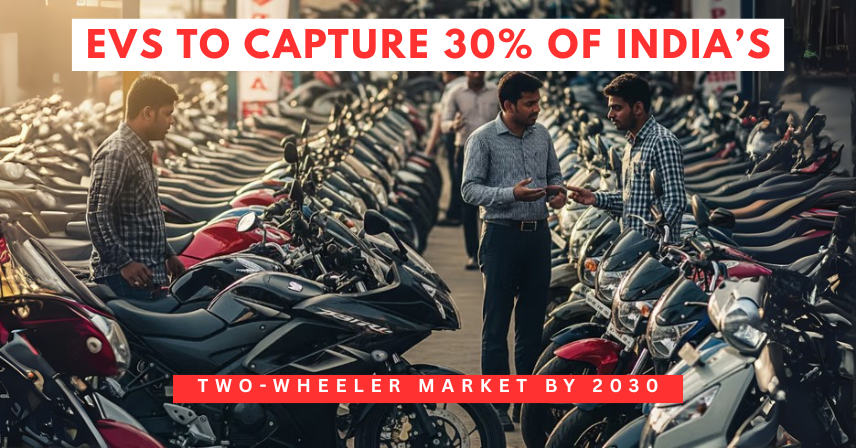Electric two-wheelers are projected to capture 30% of India’s market by 2030. Explore growth drivers, challenges, policies & future of EV bikes & scooters. India, the world’s largest two-wheeler market, is standing at the cusp of a major transformation. Electric Vehicles (EVs), particularly two-wheelers, are projected to capture 30% of the market share by 2030, reshaping how millions of Indians commute daily. With government policies, rising fuel costs, technological advancements, and growing environmental awareness, the EV revolution is gaining momentum faster than expected.
In this blog, we’ll explore the growth factors, market challenges, consumer trends, and future outlook for India’s electric two-wheeler market.
Why Electric Two-Wheelers Are the Future of Indian Mobility
Two-wheelers dominate India’s vehicle market, accounting for more than 75% of total vehicle sales. With increasing urbanization and rising fuel costs, EVs are becoming a practical and economical alternative for daily commuting.
Key reasons behind the shift:
- Rising Fuel Prices: Petrol prices remain volatile, making EVs a cost-effective solution.
- Government Incentives: Subsidies under FAME II (Faster Adoption and Manufacturing of Hybrid and Electric Vehicles) reduce upfront costs.
- Eco-Friendly Mobility: EVs reduce carbon emissions, aligning with India’s sustainability goals.
- Lower Operating Costs: EVs cost just 15–20% of what petrol bikes cost per kilometer.
- Technological Advancements: Improvements in lithium-ion batteries have extended range and reduced charging times.
Current Market Landscape of Electric Two-Wheelers in India
In 2024–25, India saw a surge in electric scooter and bike sales, with brands like Ola Electric, Ather Energy, TVS, Hero Electric, and Bajaj leading the way.
- Market Size (2025): Over 8 lakh EV two-wheelers sold in FY25.
- Projected Growth: CAGR of 45% between 2025 and 2030.
- Consumer Trends: Urban youth, delivery services, and daily commuters are major adopters.
Government Push Towards Electric Mobility
The Indian government has set a target of 30% EV adoption by 2030, and two-wheelers will play a critical role. Policies driving this growth include:
- FAME II Scheme: Offering subsidies up to ₹20,000 on electric scooters.
- PLI Scheme (Production Linked Incentives): Encouraging local EV manufacturing.
- State-Level Policies: States like Delhi, Maharashtra, and Tamil Nadu offer tax rebates, road tax waivers, and incentives.
- Charging Infrastructure Development: Targeting 10,000+ charging stations across India by 2030.
Key Players in the Indian EV Two-Wheeler Market
- Ola Electric: India’s top-selling EV scooter brand.
- Ather Energy: Known for performance-driven e-scooters.
- Hero Electric: Affordable and widely available EVs.
- TVS iQube & Bajaj Chetak EV: Popular among traditional buyers.
- New Startups: Revolt (electric motorcycles), Simple Energy, Bounce.
Challenges Facing EV Adoption
Despite rapid growth, EVs still face hurdles:
- High Initial Cost: Even after subsidies, EVs cost more than entry-level petrol bikes.
- Charging Infrastructure: Limited public charging stations in rural and semi-urban areas.
- Battery Replacement Costs: Batteries remain expensive, raising ownership concerns.
- Consumer Awareness: Misconceptions about performance, range, and reliability.
Technological Innovations Driving the Market
To overcome challenges, manufacturers are focusing on innovation:
- Swappable Battery Technology: Ola and Bounce testing battery-swapping models.
- Fast Charging Solutions: Charging time reduced from 5–6 hours to less than 1 hour.
- Smart Connectivity: IoT-enabled scooters with mobile app integration.
- Extended Range Models: Some EV bikes now offer 150–200 km range per charge.
Economic & Environmental Benefits of EV Two-Wheelers
Economic Benefits
- Running cost as low as ₹0.25 per km compared to ₹2.5–3/km for petrol bikes.
- Lower maintenance (no engine oil, fewer moving parts).
- Government subsidies and tax benefits reduce ownership cost.
Environmental Benefits
- Zero tailpipe emissions, contributing to cleaner air.
- Reduces dependency on fossil fuels.
- Supports India’s net-zero 2070 climate goal.
Consumer Perspective: Why Millennials & Gen Z Prefer EVs
Young buyers are the biggest drivers of EV adoption. For them, style, technology, and sustainability matter as much as cost. Features like touchscreen dashboards, GPS navigation, Bluetooth, and mobile connectivity make EVs more appealing to India’s tech-savvy youth.
The Road Ahead: What to Expect by 2030
By 2030, EV two-wheelers are expected to:
- Capture 30% of total sales, meaning 1 in 3 new scooters or bikes sold will be electric.
- See price parity with petrol bikes as battery costs decline.
- Become the preferred choice for delivery services like Zomato, Swiggy, and e-commerce companies.
- Drive rural adoption with affordable models and improved charging infrastructure.
Conclusion
India’s two-wheeler market is on the brink of an electric revolution. With government support, rising consumer demand, and rapid technological innovation, EVs are set to dominate by 2030. Although challenges like charging infrastructure and battery costs remain, the momentum is undeniable.
The transition from petrol bikes to electric scooters is not just about cost-saving—it’s about building a sustainable future for India’s mobility.
For more updates like this, visit www.carbikebhp.com.

